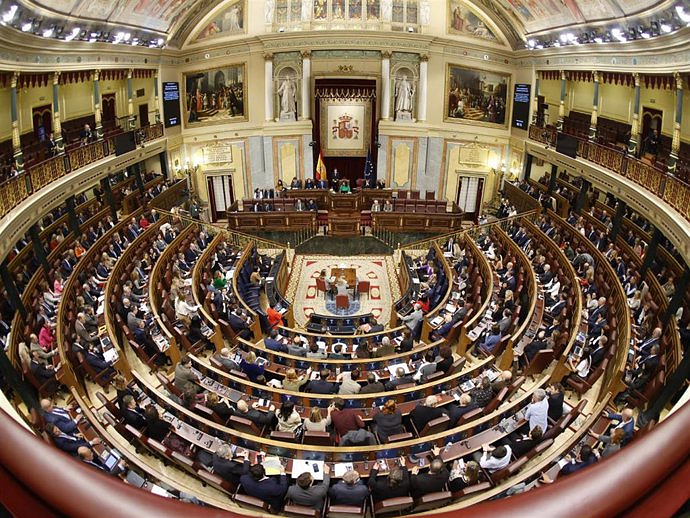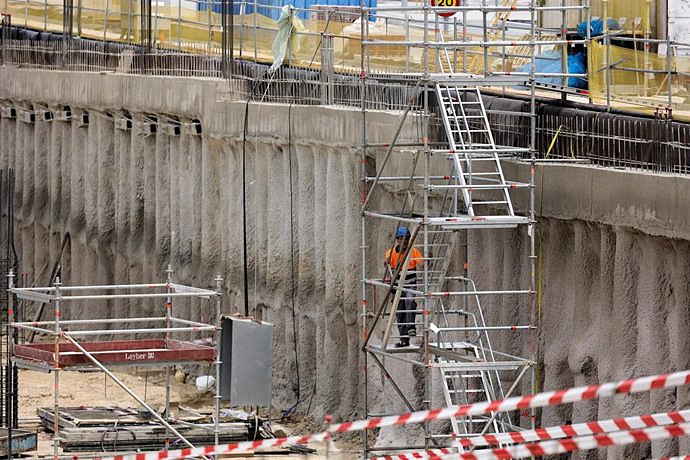The Government will have to gather all its partners again to validate their figures and then wait for the PP to lift the veto in the Senate.
MADRID, 25 Feb. (EUROPA PRESS) -
The Plenary Session of Congress next Thursday will debate and vote for the second time on the budget stability and public debt objectives for Public Administrations between 2024 and 2026, which were rejected in the Senate on February 7 thanks to the PP's absolute majority.
The Lower House already approved the objectives and the rebalancing plan on January 10 in a session held in the Senate as Congress was in progress.
The votes in favor of PSOE, Sumar, ERC, Junts, PNV, Bildu, Podemos, BNG and Canary Coalition, compared to the votes against PP, Vox and UPN, allowed the Government to overcome the process. Of course, it had to be in a second vote because in the first one a Sumar deputy, Gerardo Pisarello, made a mistake, and Junts preferred not to participate.
As there was a tie of 171 votes in that first attempt, the vote had to be repeated, and that gave Junts time to close an agreement with the PSOE in exchange for its support to, among other measures, commit to transferring immigration policies to Catalonia. Already in the second vote and after making commitments, 179 votes were cast in favor and 171 against.
But almost a month after that vote, the PP asserted its absolute majority in the Senate and overturned the objectives, thus forcing the Government, as established by the Budgetary Stability Law, to return to the box at the beginning of the process. parliamentary and approve the deficit path again in the Council of Ministers on February 13.
For the vote on Thursday, February 29, the PSOE will have to reunite all its allies and not make mistakes to carry out its plan. Later, history could repeat itself if the PP chooses to veto the stability objectives again, something that has never happened and that, for the moment, the Executive does not contemplate in its plans.
But if a second rejection is carried out in the Senate, the Ministry of Finance has a 'plan B', which is a report from the State Attorney's Office that supports setting the deficit path sent to Brussels in April within the framework of the Stability Program. Parliamentary sources confirmed to Europa Press that the report is based on article 135.2 of the Spanish Constitution to avoid blocking the Government's budgetary capacity.
Of course, the first vice president and Minister of Finance, María Jesús Montero, warned that the objectives presented to Brussels are more demanding than those proposed to the Fiscal and Financial Policy Council, so the autonomies, mostly governed by the PP, They would have less spending capacity.
In any case, the stability objectives that will be debated on Thursday are the same ones that were endorsed by Congress in January. These are accompanied by the rebalancing plan and the non-financial spending limit, the latter known as the "spending ceiling" and which is not put to a vote.
The objectives set a deficit of 3% in 2024 for all Public Administrations, 2.7% in 2025 and 2.5% in 2026. In the case of the autonomies, a target of 0.1% was established for 2024. By 2025 and 2026, communities will seek budget balance.
For local entities, the budget balance (0%) from 2024 to 2026 was also agreed, while for Social Security the deficit was set at 0.2% for 2024, 0.1% in 2025 and 0% in 2026. The spending ceiling, for its part, rises to 199,120 million euros in 2024, 0.5% more compared to the previous year, including funds from the European Union.
Regarding the public debt objective, the Government foresees 106.3% of GDP in 2024, 105.4% in 2025 and 104.4% in 2026. Finally, the spending rule is at a 2.6% for this year, 2.7% in 2025 and 2.8% in 2026.

 Exploring Cardano: Inner Workings and Advantages of this Cryptocurrency
Exploring Cardano: Inner Workings and Advantages of this Cryptocurrency Seville.- Economy.- Innova.- STSA inaugurates its new painting and sealing hangar in San Pablo, for 18 million
Seville.- Economy.- Innova.- STSA inaugurates its new painting and sealing hangar in San Pablo, for 18 million Innova.- More than 300 volunteers join the Andalucía Compromiso Digital network in one month to facilitate access to ICT
Innova.- More than 300 volunteers join the Andalucía Compromiso Digital network in one month to facilitate access to ICT Innova.-AMP.- Ayesa acquires 51% of Sadiel, which will create new technological engineering products and expand markets
Innova.-AMP.- Ayesa acquires 51% of Sadiel, which will create new technological engineering products and expand markets Abascal (Vox) criticizes that Sánchez is "victimizing" himself and calls for elections after his possible resignation
Abascal (Vox) criticizes that Sánchez is "victimizing" himself and calls for elections after his possible resignation Carlos Alcaraz reaches the round of 16 in Madrid without breaking a sweat
Carlos Alcaraz reaches the round of 16 in Madrid without breaking a sweat Some 5,000 people demonstrate in front of Congress for democracy, hours before Sánchez's decision
Some 5,000 people demonstrate in front of Congress for democracy, hours before Sánchez's decision STATEMENT: Intelligent systems used in the construction of the deepest underwater tunnel in China
STATEMENT: Intelligent systems used in the construction of the deepest underwater tunnel in China How Blockchain in being used to shape the future
How Blockchain in being used to shape the future Not just BTC and ETH: Here Are Some More Interesting Coins Worth Focusing on
Not just BTC and ETH: Here Are Some More Interesting Coins Worth Focusing on UPV students build a prototype of a wooden house to move to Equatorial Guinea
UPV students build a prototype of a wooden house to move to Equatorial Guinea The UA opens the call for the Impulso 2024 Awards for the best innovative business initiatives
The UA opens the call for the Impulso 2024 Awards for the best innovative business initiatives ALI, virtual assistant from Alicante, internationally recognized by the OECD
ALI, virtual assistant from Alicante, internationally recognized by the OECD Retrópolis brings the golden age of video games and computing to the UPV
Retrópolis brings the golden age of video games and computing to the UPV A million people demonstrate in France against Macron's pension reform
A million people demonstrate in France against Macron's pension reform Russia launches several missiles against "critical infrastructure" in the city of Zaporizhia
Russia launches several missiles against "critical infrastructure" in the city of Zaporizhia A "procession" remembers the dead of the Calabria shipwreck as bodies continue to wash up on the shore
A "procession" remembers the dead of the Calabria shipwreck as bodies continue to wash up on the shore Prison sentences handed down for three prominent Hong Kong pro-democracy activists
Prison sentences handed down for three prominent Hong Kong pro-democracy activists ETH continues to leave trading platforms, Ethereum balance on exchanges lowest in 3 years
ETH continues to leave trading platforms, Ethereum balance on exchanges lowest in 3 years Investors invest $450 million in Consensys, Ethereum incubator now valued at $7 billion
Investors invest $450 million in Consensys, Ethereum incubator now valued at $7 billion Alchemy Integrates Ethereum L2 Product Starknet to Enhance Web3 Scalability at a Price 100x Lower Than L1 Fees
Alchemy Integrates Ethereum L2 Product Starknet to Enhance Web3 Scalability at a Price 100x Lower Than L1 Fees Mining Report: Bitcoin's Electricity Consumption Declines by 25% in Q1 2022
Mining Report: Bitcoin's Electricity Consumption Declines by 25% in Q1 2022 Oil-to-Bitcoin Mining Firm Crusoe Energy Systems Raised $505 Million
Oil-to-Bitcoin Mining Firm Crusoe Energy Systems Raised $505 Million Microbt reveals the latest Bitcoin mining rigs -- Machines produce up to 126 TH/s with custom 5nm chip design
Microbt reveals the latest Bitcoin mining rigs -- Machines produce up to 126 TH/s with custom 5nm chip design Bitcoin's Mining Difficulty Hits a Lifetime High, With More Than 90% of BTC Supply Issued
Bitcoin's Mining Difficulty Hits a Lifetime High, With More Than 90% of BTC Supply Issued The Biggest Movers are Near, EOS, and RUNE during Friday's Selloff
The Biggest Movers are Near, EOS, and RUNE during Friday's Selloff Global Markets Spooked by a Hawkish Fed and Covid, Stocks and Crypto Gain After Musk Buys Twitter
Global Markets Spooked by a Hawkish Fed and Covid, Stocks and Crypto Gain After Musk Buys Twitter Bitso to offset carbon emissions from the Trading Platform's ERC20, ETH, and BTC Transactions
Bitso to offset carbon emissions from the Trading Platform's ERC20, ETH, and BTC Transactions Draftkings Announces 2022 College Hoops NFT Selection for March Madness
Draftkings Announces 2022 College Hoops NFT Selection for March Madness























